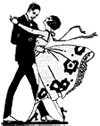 |
ROUND DANCING — CHOREOGRAPHED BALLROOMEDUCATIONAL ARTICLESMAJOR SECTIONS: Figures | Articles | Links | Alph. Index | Search | Home |
|
|
What About Feathers?by Roy & Phyllis Stier To "feather" is to step outside partner while still maintaining parallel shoulders; in other words, a reluctant banjo or sidecar deviation from closed position. We borrowed the feathers from ballroom, where it is a fox trot mainstay, so we need to check out some interpretations. They do not use the sidecar position except for a few occasions where the man is backing up. The primary use is called the "feather step" where the couple goes from closed position to a contra banjo position in 3 steps (R, -, L, R; for the man) without changing direction and ending with a feeling of locked thighs. If we arrived at the same point starting from semi-closed position in 3 steps, it would be a "feather ending." The 3rd way to do this type of feather is from CP where he man steps back on his 1st step (R), -, then side and slightly forward, then to the feather in contra body (lady opposite). This is the "feather finish" and is the usual way to end such things as the Reverse Turn, Weave, Top Spin, etc.Now, as to the other figures that are part of the feather family — just a few comments. Probably the next in line for common usage is the Curved Feather Check, which is often confused with the Hairpin, as used in waltz rhythm (normally 4 steps). Again, the slow, -, quick, quick; is used to curve around the lady to end with a right sway to check forward motion and set the stage for a backward step on the man's left foot. The Back Feather often follows, as the lady is kept outside in strong contra banjo, and the man steps back on his left while starting to change sway (right shoulder lead), then passing steps R, L, while curving to the left. The Left Feather is a little more tricky because it is a left-face turn on a slow to start outside partner, then 4 quicks that resemble a weave then never blends to closed position with the man's head kept to the left. Almost always this leads to a Feather Finish. There is a figure called the Back Left Feather which follows a Reverse Turn that puts the lady outside in contra banjo for a couple of passing steps in preparation for a Feather Finish to diagonal wall. One group, called the Four Feathers, has been used on occasion for round dancing and consists of the following: A standard Feather Step moving line of dance or thereabouts, then the Left Feather, followed by the Back Left Feather (3 steps) and then the Feather Finish to end diagonal wall. Actually, we can work in any combination that fits, even if we split measures — as long as you get back on the downbeat soon. The technique of looking well on the floor doing the feathers is tied up in body rise (end of 1st step but not too high) and in using a subtle sway to accompany the smooth transition from one step to the next. The "regrouping" between figures that is characteristic in waltz is not used in fox trot. Good luck, you feather fans!
This column comes from a series published in Cue Sheet Magazine between 1987 and 1992, and is reprinted with permission. The full series is collected in an 86-pg booklet, available for $30.00 plus postage. E-mail Fran Kropf at cutecuer@cox.net. This article was published in the Dixie Round Dance Council (DRDC) Newsletter, January 2009.
|
 |
|
|
Page last revised